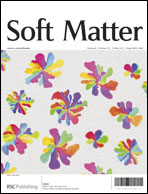From compact to fractal crystalline clusters in concentrated systems of monodisperse hard spheres
Abstract
We address the crystallization of monodisperse hard spheres in terms of the properties of finite-size crystalline clusters. By means of large scale event-driven molecular dynamics simulations, we study systems at different packing fractions ϕ ranging from weakly super-saturated state points to glassy ones, covering different nucleation regimes. We find that such regimes also result in different properties of the crystalline clusters: compact clusters are formed in the classical nucleation theory regime (ϕ ≤ 0.54), while a crossover to fractal, ramified clusters is encountered upon increasing packing fraction (ϕ ≥ 0.56), where nucleation is more spinodal-like. We draw an analogy between macroscopic


 Please wait while we load your content...
Please wait while we load your content...